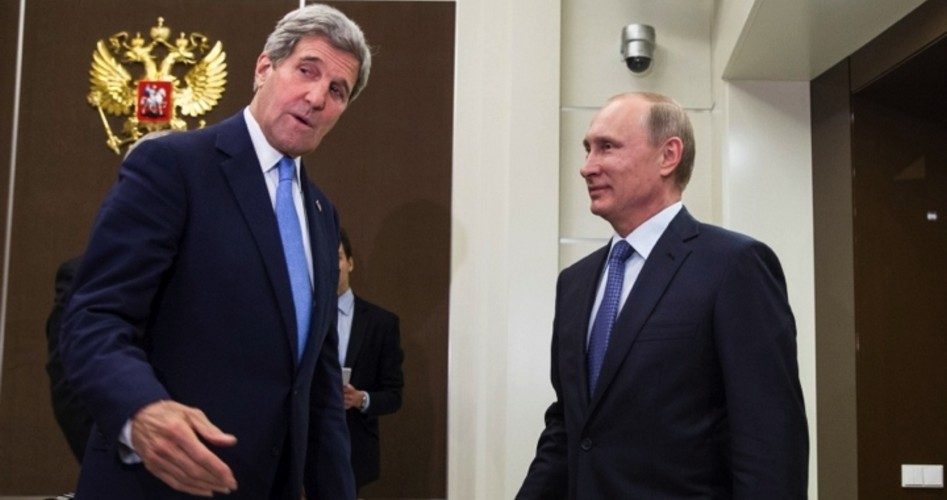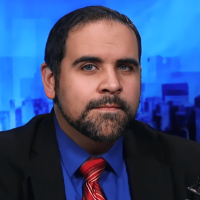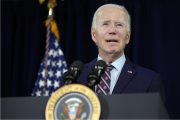
In an interview with Russian interstate channel Mir TV, U.S. Secretary of State John Kerry invited China and Russia to join the Trans-Pacific Partnership (TPP).
“We invite people to come join other initiatives, like the Trans-Pacific Partnership, the TPP. We welcome China, we welcome Russia, we welcome other countries who would like to join, as long as they want to raise the standards and live up to the highest standards of protecting people and doing business openly and transparently and accountably,” said Secretary Kerry.
The TPP is a proposed “trade” pact negotiated among 12 Pacific Rim nations (Australia, Brunei, Canada, Chile, Japan, Malaysia, Mexico, New Zealand, Peru, Singapore, the United States, and Vietnam) representing 40 percent of global GDP. On October 5, 2015, U.S. Trade Representative Michael Froman announced that the United States and the 11 other participating Pacific Rim nations had reached a final agreement on the TPP.
Mir TV filmed the televised interview on November 2, 2015, in Astana, Kazakhstan, during Secretary Kerry’s tour of Central Asia. An official English transcript of the interview was made available by the State Department online.
Kerry’s formal invitation of TPP membership to Communist China and Russia further corroborates what we in The New American magazine, both online and in print, have reported on numerous occasions: The plan of those promoting the TPP has been to include both China and Russia from the start. (See here, here, here, and here).
On August 23, 2013, in “Regional Scheme for the Pacific Rim,” The New American reported:
The TPP, which currently involves 12 nations — Australia, Brunei, Canada, Chile, Malaysia, Mexico, New Zealand, Peru, Singapore, the United States, and Vietnam (Japan is negotiating for membership and is likely to join soon) — is really intended as an interim arrangement, on the road to an expanded Free Trade Area of the Asia Pacific (FTAAP) that would include all 21 nations of the grouping known as the Asia-Pacific Economic Cooperation (APEC). That includes China and Russia. [Emphasis added].
In the print version of “Trans-Pacific Partnership to Facilitate U.S.-China Merger,” published in the February 2, 2015 issue of The New American magazine (as opposed to the earlier December 2014 online version of the article with the same title), we reported:
Here is the deception: TPP proponents know that a large American constituency is already very alarmed over the outsourcing of jobs and industry to China and the huge inroads that China is making into the American economy. So TPP advocates are telling this concerned audience that the TPP — which, at present, does not include China — will give American workers and companies a big new advantage against competition from China. However, these same TPP proponents are duplicitously telling other audiences that China will probably be admitted into the TPP and that, at any rate, the final game plan is to have the TPP subsumed into the larger planned Free Trade Area of the Asia Pacific (FTAAP), which will include not only Communist China, but Russia as well.
The article further stated “the TPP is merely a ‘steppingstone’ (their term) to U.S.-China convergence in the larger FTAAP.” Russia could also be added to the mix of convergence as detailed in The New American’s recent article, “Russia’s Backdoor Participation in the Trans-Pacific Partnership (TPP),” and by Secretary Kerry’s televised invitation on Mir TV.
In an interview with RT (Russia Today), published online on November 6, 2014, Russian President Vladimir Putin was asked to “assess the prospects for APEC if the TPP is formed.” Demonstrating that he sees regional “trade” agreements as vehicles for larger global convergence, Putin replied, “Russia seeks to strengthen regional economic integration. Moreover, we also believe that free trade agreements should not fragment the multilateral trading system, but rather complement [it], contribute to its consolidation and the growth of interconnectedness.”
The Russian strongman observed of the TPP, “I believe that the absence of two major regional players such as Russia and China in its composition will not promote the establishment of effective trade and economic cooperation.” In other words, for the TPP to succeed, it must include both Russia and China.
Kerry’s revelation also vindicates the criticisms of other TPP opponents such as Senator Jeff Sessions (R-Ala.), and presidential candidates Senator Bernie Sanders (I-Vt.) and Carly Fiorina, all of whom have raised concerns about China’s possible entry into the TPP.
On May 6, 2015, in an open letter to President Obama about the TPP, Senator Sessions asked, “Regarding China: Can TPP member countries add new countries, including China, to the agreement without future Congressional approval?”
Four days later, on May 10, 2015, Republican presidential candidate and former Hewlett-Packard CEO Carly Fiorina appeared on NBC’s Meet the Press, where she also brought up similar concerns. “I think it’s important to know some of the fine print of this deal. For example, is China allowed to join this Pacific trading agreement later on in a couple years, yes or no?” Fiorina further asked, “If the truth is in these details that China gets to join later, then what exactly are we doing here?”
In a 3-page PDF document posted on Bernie Sanders’ official Senate website, he also brings up the same concerns of China’s entry into the TPP at a later date. “Once TPP is agreed to, it has no sunset date and could only be altered by a consensus of all of the countries that agreed to it. Other countries, like China, could be allowed to join in the future,” Senator Sanders wrote.
Kerry’s invitation for China and Russia to join the TPP destroys the false narrative that the TPP is intended to either contain or curb the rising economic influence of both China and Russia in the Pacific. Instead, it further demonstrates that the goal of the TPP is convergence in the form of an even larger proposed trade pact known as the Free Trade Area of the Asia-Pacific (FTAAP). This too validates the argument that the TPP is not about real free trade in the classical sense of the term, but rather the creation of global governance structures, hence Kerry’s and other TPP proponents’ persistence on “writing the rules” and to “raise the standards.” The TPP rules and standards are merely a pretext for regional governance under the umbrella of the FTAAP with the dictatorships of both Vladimir Putin’s Russia and Xi Jinping’s Communist China in the forefront.
Photo of U.S. Secretary of State John Kerry and Russian President Vladimir Putin: AP Images
Related articles:
Russia’s Backdoor Participation in the Trans-Pacific Partnership (TPP)
China Seeks to Join Trans-Pacific Partnership (TPP)
Globalists Now Pushing To Bring China Into TPP
Chinese Diplomat: TPP, FTAAP “Compatible; Complement Each Other”
Trans-Pacific Partnership To Facilitate U.S.-China Merger
Obama Considering Chinese Participation in Trans-Pacific Partnership
Putin’s East vs. Globalist West: Merging Into a New World Order
Putin & Xi Stress Beijing-Moscow Ties at APEC




